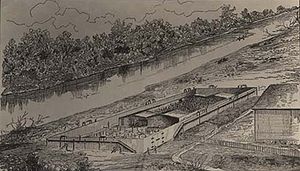Cahaba Prison
| Cahaba Prison Castle Morgan |
|
|---|---|
| Cahaba, Alabama, U.S.A. | |

"Castle Morgan, Cahaba, Alabama, 1863–65. Drawn from memory by the author." From Jesse Hawes' Cahaba, A Story of Captive Boys in Blue.
|
|
| Type | Confederate Prison Camp |
| Site history | |
| Built | 1863 |
| In use | 1863–1865 |
| Battles/wars | American Civil War |
Cahaba Prison, also known as Castle Morgan, was a prisoner of war camp in Dallas County, Alabama where the Confederacy held captive Union soldiers during the American Civil War. The prison was located in the small Alabama town of Cahaba, at the confluence of the Alabama and Cahaba rivers, not far from Selma. It suffered a serious flood in 1865. At the time, Cahaba was still the county seat, but that was moved to Selma in 1866.
The Confederate Army built a stockade around a large cotton warehouse near the Alabama River to prepare the site. Cahaba Prison was opened as such in June 1863. The commanding officer was Captain H. A. M. Henderson, a Methodist minister. The prison made use of a brick cotton warehouse built in 1860 on Arch Street, above the banks of the Alabama River. This structure covered approximately 15,000 square feet (1,400 m2) and was surrounded by a larger wooden stockade. It was intended for approximately 500 prisoners, but its population had grown to 660 by August 1864. When Union General Ulysses S. Grant suspended the practice of prisoner exchange with the Confederacy, the numbers began to soar. By October 1864 the number of prisoners held here was 2,151; they had increased to more than 3,000 by March 1865.
Former prisoner Jesse Hawes describe the two men in charge by the following: Captain Howard A. M. Henderson was "remembered with kindly wishes…It was often in the power of Henderson to extend kindnesses and courtesies to prisoners, and we are glad to note that the opportunity was not infrequently embraced." But he wrote of Lieutenant-Col. Samuel Jones, "we find one whose record was a sickening blotch upon humanity...The relations between Jones and Henderson were never cordial, and at times were quite unfriendly. It was urged by one or two of the guards that Jones, when not drunk, was less brutal then he would ordinarily seem; but unfortunately for the poor wretches whose very lives depended on his moods, he was never seen by us except when intoxicated."
Jacob Rush of the 3rd Ohio Cavalry enlisted at age 15, having lied about his age. He was captured as a spy, met with General Nathan Bedford Forrest, and was sent to Cahaba Prison, arriving on October 13, 1864. While there he met Union Captain Hanchette and helped organize an escape attempt. They were successful in capturing the guards, but the demoralized condition of the prisoners resulted in a failed attempt. Confederate reinforcements came from the town and the prisoners were charged with conspiracy. Captain Hanchette refused to give up the names of the men involved, and none of the other prisoners admitted to them, either. The suspected conspirators were kept four days without rations. Jacob Rush and Jesse Hawes, M. D. later wrote first-hand accounts of the prison, the conditions, and the escape attempt.
...
Wikipedia
